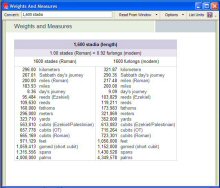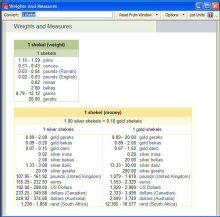One of the features of Libronix DLS that was completely redesigned for version 3.0 was the weights and measures calculator.
Click on the thumbnail to take a look at an example. This example was taken from Revelation 14:20, where we’re given an image of a horse-high river of blood running 1,600 stadia. Ick, right? But enquiring minds want to know, just how icky are we talking about here? So I click ‘Tools | Bible Data | Weights and Measures’ and enter ‘1,600 stadia’. I could have used ‘stade’, ‘stades’, ‘stadion’, ‘stadioi’ or ‘furlong’ if I wanted. A stade is an eighth of a mile, but the length of a mile in Roman times was different than today’s standard mile. One of the really cool features of the new calculator is that it doesn’t assume it knows which stade length you want, nor does it assume you know that there are two lengths to choose from. Instead, it displays both.
Note the second line of the results: 1.00 stades (Roman) = 0.92 furlongs (modern). (A furlong is another name for an eighth of a mile, the report just happens to call the modern measurement a furlong, though as you can see, it is savvy enough to show furlongs when you ask for stades.) So right away you are informed that the measurement for a stade will be different depending on which stade you are interested in (Roman or modern), even if you didn’t know there was a choice!
Beneath the conversion formula between the related measurements, the report is split into columns, one column for each measurement that 1,600 stadioi might be referring to. From here, it is easy to look up conversions to other measurements of length, such as kilometers or miles. Again, each list shows ‘miles (Roman)’ as distinct from the modern standard ‘mile’. 1,600 Roman Stadioi equals 200 Roman miles, but only 183.93 modern standard miles.
Take a look at the next example. Here I entered 1 shekel, but a shekel can be a measurement of weight or of money. And when it is money, it might be gold or silver. (The modern Israeli shekel is not listed here, though that would have been an interesting addition to this table.) Note how two different charts of two different colors make it easy to separate out the different kinds of shekels. Again, you didn’t need to know that there are three different things a shekel could refer to in order to see the conversion charts.
Trying to fathom (pun intended) modern equivalents to ancient measurements is always a bit difficult, and exact precision often eludes us. But with Logos Bible Software, getting to reasonable estimates just got easier than ever.






